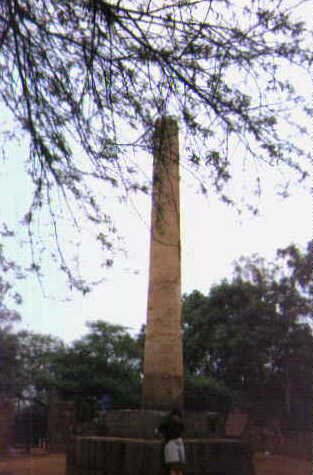|
L I B R A R Y , G H A Z I P U R. |
|
Sub-Head______________ Serial No. :51 |
|
|
MEERUT:
A GAZETTEER ,
BEING
VOLUME IV
OF THE
DISTRICT GAZETTEERS OF THE UNITED
PROVINCES OF AGRA AND OUDH
COMPILED AND EDITED BY
H. R. NEVILLE, I.C.S
A L L A H A B A D :
PRINTED BY F.LUKER, SUPDT., GOVT. PRESS, UNITED PROVINCES
1904
Price Rs. 3 (4s.).
The name Meerut , properly spelled Merath or Mirath, is variously derived. According to one account it was originally known as Mahi Rashtra, the name given to it by one Mahi, a distinguished architect, who built a palace at Indraprashta or Dehli, in exchange for which he received the land on which Meerut now stands from the king Yudhishthira. This Mahi is said to have built the Andar Kot, a high brick fortress , the remains of which are still (1904) traceable . The Jats on the other hand, allege that Meerut was founded by a colony of their cast belonging to the Maharastra Gotra. Others say that Meerut received its name from Mahipal, king of Dehli. Still another derivation is to be found in the tradition that the place was in very ancient times called Mahidant-ka-khere . None of those provide a very satisfactory explanation for the name; but that Meerut was inhabited in very ancient times is evident from the fact that the Ashoka pillar that now stands on the ridge at Delhi was erected by the Great Buddhist Emperor in the 3rd century before Christ. This fact is attested by the inscription on the pillar, which states that the monument was removed from Meerut to Dehli by Firoz Shah in 1206 A.D. The existence of this pillar and the discovery of Buddhist remains within the city leave little room for doubt that Meerut was an important centre of Buddhism in the time of Ashoka , although no mention of the place is made by Chinese travelers , which possibly points to its decay at an early date.
At a later period Meerut was captured by Saiyid Salar Masaud in his invasion of Hindostan .In the eleventh Century Hardatta , the Dor ruler of Baran or Bulandshahr , Koil and Meerut built a fort which , according to Taj-ul-Maasir of Hasan Nizami, was one " of the celebrated forts of the country of Hindustan, for the strength of its foundation and superstructure and its ditch which was broad as the ocean and fathomless".(This is why a lot of sensible people stay away from History ). This fort was captured by Qutb-ud-din in 1191 AD and all the Hindu temples were converted into mosques. In 1327 AD the Mughal chieftain Tarmsharin Khan , made an unsuccessful attack on the city, but it was completely sacked and destroyed by Timur in 1399 AD. Several centuries later , in 1788, the fort was taken by the Mahrattas after a severe struggle with the Musalman Garrison under Ghulam Qadir. The place was of sufficient importance in Akbar's day to be a mint for copper coins . Mr. Guthrie , writing in 1805 , says :" Meerut is a ruinous, depopulated town and a place of no trade . The average net market dues for four years amount to only Rs. 2,535." ( This is around 1900 , now through imaginative taxation it is 1000's of crores per year - excise etc. You must be joking little is used, that too sporadically , for the town's improvement ) It soon however began to recover . The cantonment was first established in 1806 , and in 1808 the cavalry and infantry barracks were commenced by a Major Penson . The remaining history of the city will be found in the account of the district.
Thanks to Mr. V.K.Sharma for sending some more details - e-mail dated 24-1-2003
Phone : 011-23016917 Email : vks@ub.nic.inI must apologies that I am writing to you after a long gap. After your mail. Actually I spoke to some people for some detailed information about Meerut. Mr. V.P. Sharma, Sr. Accounts Officer, CGDA, New Delhi has gave me several interesting details about Ancient Period links of Meerut. Some of them are :

Did you know that there is a discussion on about whether Asoka actually built the pillars ? Here is someone who says that Ashoka made his inscriptions on already existing pillars. These pillars he says are the long lost altars of Alexander the Great (13 of them ).
Click here to read the page.That seems unlikely as Alexander is known to have stayed on this side of the Indus for only a few months. The pillars are made of stone from Chunar and are found at great distances from the Indus.
The other side of the coin is that the inscriptions on the pillar do look like scribbling ( the face is not even plained like for the edicts ). Not only that it seems Firoz Shah ( only 16 centuries later ) may have known that these pillars may have been shifted from their original site along the Beas, and thought nothing of shifting them again, another one in Delhi near the Firoz Shah Kotla grounds comes from Topra ( where is / was Topra ? ).